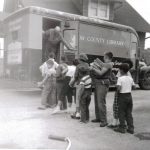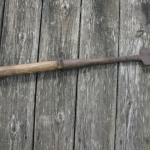 The Door County Bookmobile was the rural public library. In 1950 when the Door-Kewaunee Regional Library Demonstration first brought bookmobiles to the Door Peninsula, nearly 23% of Wisconsinites did not have access to a free library. With many remote towns and islands, a low overall population, poor transportation, and low literacy rates, the Door Peninsula offered an opportunity to test the bookmobile model for extending rural library services. During the Demonstration period, libraries in Door and Kewaunee Counties saw a 160% increase in circulation, and most of this came from books borrowed by rural schoolchildren and women. After a referendum in 1952, Door County continued the program on its own.
The Door County Bookmobile was the rural public library. In 1950 when the Door-Kewaunee Regional Library Demonstration first brought bookmobiles to the Door Peninsula, nearly 23% of Wisconsinites did not have access to a free library. With many remote towns and islands, a low overall population, poor transportation, and low literacy rates, the Door Peninsula offered an opportunity to test the bookmobile model for extending rural library services. During the Demonstration period, libraries in Door and Kewaunee Counties saw a 160% increase in circulation, and most of this came from books borrowed by rural schoolchildren and women. After a referendum in 1952, Door County continued the program on its own.
The bookmobile became an important tool connecting rural communities in Wisconsin to each other and to the rest of the state. The bookmobile was also an extension of the rural schools. It provided popular novels, classics and children’s stories and books in English as well as several native languages, agricultural magazines, do it yourself manuals for farmers and homemakers, and books for those interested in business. Inspired by the Wisconsin Idea, the creators of the Door County Bookmobile referred the bookmobile program as “the Idea in action.” Its goal was to help bridge the literacy gap in rural Wisconsin and build cooperation with and among the people of the region.
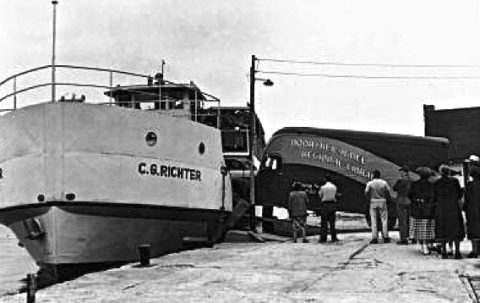
The post World War II boom, expansion of the suburbs and the Library Services Act all helped increase demand for mobile library service across the United States. This created a niche industry for those who specialized in designing and manufacturing custom vehicles. A few companies took advantage of the opportunity and began the custom design of bookmobiles. The Door County Bookmobile was designed by the king of the bookmobile manufacturing industry, the Gerstenslager Company of Wooster, Ohio. Already a maker of fire trucks, mobile x-ray vans, television units and even the Oscar Meyer Weinermobile, they were well-suited to occupy this new niche. Soon the company held a near monopoly on bookmobiles, enjoying 90% of the market.
Their success was due to quality, craftsmanship and a well-designed national advertising tour in 1949 to unveil their pioneer bookmobile model. Each Gerstenslager bookmobile was custom-built and painted according to the needs of the individual library. The original Door County Bookmobile was built in 1950, but it was worn-out by 1967. This model was its replacement. It was built by the Gerstenslager Company in 1964.
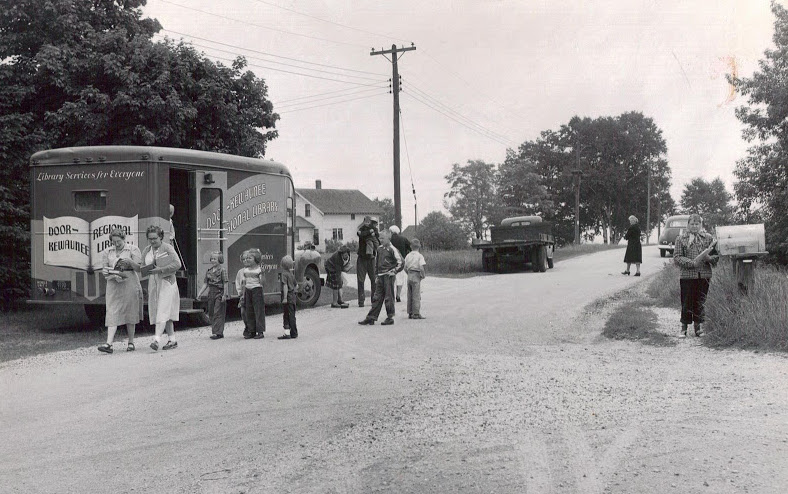
According to the Gerstenslager Company, the Door County Bookmobile model was classified as a Medium Bookmobile that could hold 1500-2500 volumes of books. It had an interior space 16 feet long and 7 feet in width; and an interior height of 6 feet 6 inches. The roof was an all-steel turret-type with two skylights to let in natural light. Two service doors on the right side of the vehicle allowed visitors to enter at the front and exit through the back. The cab compartment had two bucket seats, one for the driver and one for a helper, both seats were adjustable and reversible.
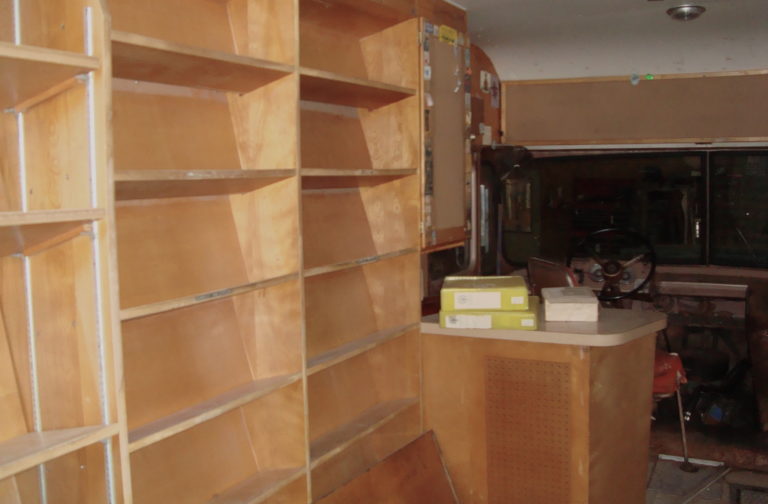
Inside the bookmobile, fluorescent fixtures provided lighting and the interior shelving was carefully designed using wood and steel shelving installed according to ALA standards. Each shelf was pitched at an angle and covered with rubber mats to keep books in place. The bookmobile included special sections with magazine racks, space for children’s books and oversize books, and a clothes closet in the left rear corner. A record cabinet, built beneath the rear window, had shelves to carry a supply of record albums. The top of the cabinet provided space for a record player. The appliance outlet at the rear of the vehicle provided an electrical connection for this purpose. And of course the necessary charge-out desk sits was behind the driver’s seat was covered with battleship linoleum to match the floor.
Listen below to the Door County Bookmobile’s segment on Wisconsin Public Radio’s Wisconsin Life.
Written by Julie Hein, November 2017.
Object courtesy of the Egg Harbor Historical Society
SOURCES
Pawley, Christine. “Blood and Thunder on the Bookmobile: American Public Libraries and the Construction of ‘the Reader,’ 1950-1995” in Augst, T. & Carpenter, K., Institutions of Reading: The Social Life of Libraries in the United States (Amherst: University of Massachusetts Press, 2007), 264-282.
Pawley, Christine. Reading Places: Literacy, Democracy, and the Public Library in Cold War America (Amherst: University of Massachusetts Press, 2010).
Door County Library Memorandum August 4th 1989.
Door County Advocate, December 3rd 1974.
Congressional Record– House (81st Congress 2nd session) 6 (3) March 9, 1950, 3129.
University of Illinois Library School Occasional Papers, Number Nine (April, 1950) “Basic Bookmobile Specifications.”
